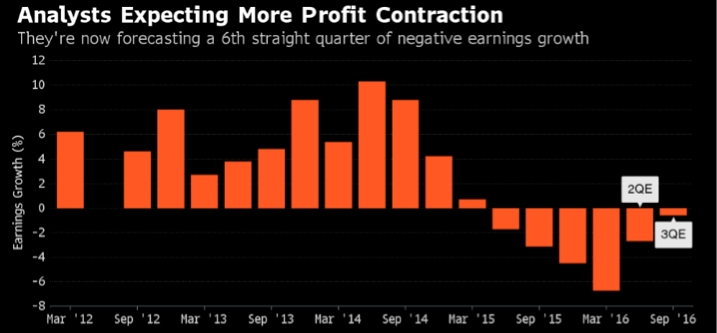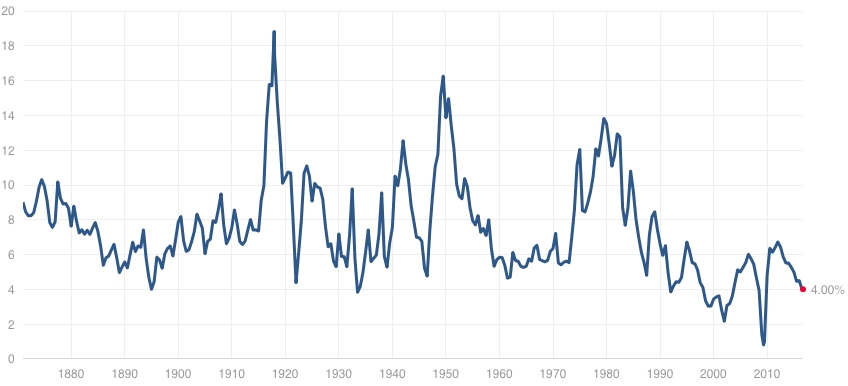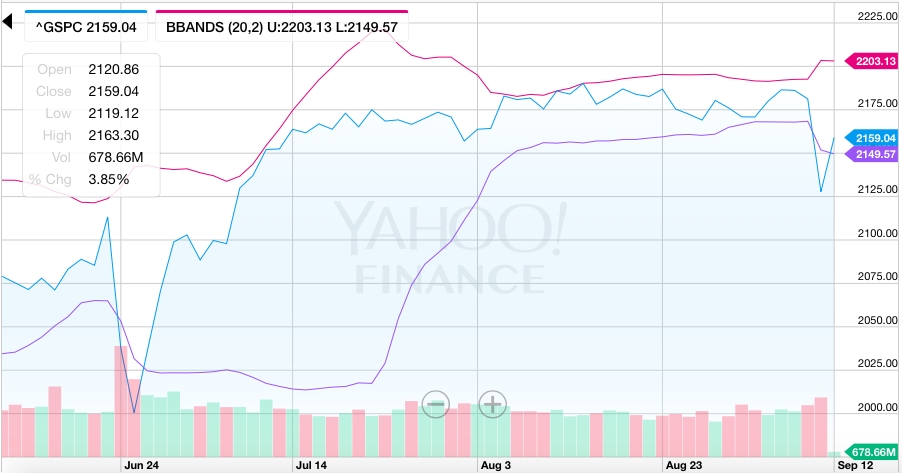After a 2- day sell-off following Brexit, the S&P 500 and Dow Jones Industrial Average have rallied 9.3% and 8.16% respectively, in anticipation of increased loose monetary policy conditions from central banks.
However, with the indexes hitting new all- time highs, investors may have become overly optimistic on the stock market. The chart below shows Goldman’s sentiment indicator, which now stands at 100. This reflects that traders have overbought long positions in the futures market, and how bullish sentiment has reached the maximum level possible. Which raises the question, is there much to be optimistic about for stocks going ahead?
For 6 weeks the Volatility Index (VIX) was hovering around 12, near its lowest level in 52 weeks. Traders have simply become too complacent, encouraging analysts to question if this was the calm before the storm?
Firstly, the recent stock market rally and burst of bullish bets creates a steep cliff for stocks to fall off of. In fact, even the slightest bad news is able to cause a severe downturn in the market, as those overly bullish bets rapidly unwind.
Monetary Policy Outlook
The market’s sensitivity was evident in the market sell- off on Friday September 9. When Eric Rosengren, the chief of the Federal Reserve Bank of Boston, turned from dovish to hawkish on US monetary policy by highlighting the risks of prolonged periods of low interest rates, markets went into mayhem, with the Dow Jones Industrial closing 394 points down for the session.
However that same day, Daniel Tarullo, a more influential member of the Federal Reserve, made a dovish statement. Regardless, the market remained more focused on the negative statement than the positive statement, highlighting the sensitivity of the market to any hint of bad news.
A rise in interest rates means stocks are valued using a higher discount rate (the rate used to find the present value of the future cash flows). But current stock valuations have not priced this in yet. Hence, stock prices may have to adjust downwards to price in tighter monetary policy conditions, creating downward pressure on the market.
Looking back at historical trends, a hawkish tone from the Federal Reserve usually creates the perfect setting for a market downturn. After hiking rates in December 2015, the Fed issued projections stating that they expect to raise interest rates 4 times during 2016.
As a result, markets sold off sharply in January 2016 as the slightest bad news from China spread panic across markets, fearing that the global economy is not ready for tighter US monetary policy conditions.
Similarly, a more hawkish Fed could once again make the market more sensitive to bad news. In fact, with a P/E ratio of 24.9, the S&P 500 is more overvalued now than it was back in December 2015 before the downturn, making the market seem even more fragile.
Economic Data
Recent economic data releases have also been mixed. The recent ISM Non-Manufacturing Index came in weaker than expected at 51.4. Whereas the recent JOLTS report showed a healthy 5.871m jobs were opened in July.
The combination of weak and strong economic data releases has made it even harder for the market to judge when the Fed will raise rates. This uncertainty with a hint of hawkishness from some Fed members may dampen the market’s ability to continue rallying in the near- term.
Nevertheless, investors should keep an eye on upcoming data. Retail Sales and Producer Price Index will be released on September 15, and Consumer Price Index will come out on September 16. These reports could give more clues on when the Fed might hike rates again.
Q2 Earnings Season
70% of S&P 500 companies beat earnings expectations in Q2 2016, and 53% beat revenue expectations. However, we had entered the second quarter earnings season with an ‘Aim Low and Avoid Disappointment’ sentiment, as corporate earnings guidance and analyst estimates were revised downwards to avoid an earnings miss during the season.
In fact, 60% of companies have already lowered their estimates for Q3 2016, and as a result, earnings for the S&P 500 is expected to decline by 2%, which would mark the sixth consecutive quarter of negative earnings growth.
Stock prices and Earnings Per Share have continued to diverge, encouraging analysts to question the market’s current valuation, as the S&P 500 hits new all- time highs and its Earnings Yield has fallen from 6% to 4% over the past few years.
S&P 500 Earnings Yield
Election Uncertainty
Election polls have also been weighing on markets lately, as Trump gains lead. According to a new CNN poll, Trump stands at 45% and Hillary at 43%. Part of the reason why markets were calm over the summer was because Hillary was in the lead, and markets tend to prefer stability over uncertainty. A shift from Obama to Clinton would introduce limited changes. Whereas a Trump administration would be a massive shift, and the lack of clarity of his positions on various issues does not help either.
However, one thing is for sure, a Trump presidency would lead to a reversal in the Health Care sector rally, which has been a leader of the bull market over the past several years. Hence a breakdown in this defensive sector would kill one of the pillars of the stock market’s strength.
Technical Indicators
Technical indicators also seem to paint a dark picture for the market. The monthly Stochastic Oscillator, a momentum indicator, currently stands at 81.35, signalling overbought conditions, as traders have been overly bullish on the market.
This overbought condition is confirmed by the monthly Williams Percentage Range indicator, which has a reading of -17.2. A reading between 0 and -20 signals severe overbuying in the market. Hence a pullback in the market should not come as a surprise.
Bollinger Bands®, the volatility indicator, for the market also indicate there will be volatility ahead. The chart below shows how the market has been trading between a very narrow range throughout August. Periods of narrow band ranges are usually followed by periods of wider band ranges, and vice versa. The only question is whether the next range- widening move will be downward or upward. Well, the chart demonstrates how the Friday sell- off led to a notable breakout downward, and market fundamentals suggest this market downturn will continue.
Bearish traders have been forced to wait patiently on the sidelines as the Post- Brexit stock market rally dominated the summer. However, the abnormally long period of low volatility is not likely to continue as monetary policy and election uncertainty return. Market bulls have managed to stretch valuations even higher over the past few months, which creates a more lucrative opportunity for the bears to cash in on when the rally finally bursts. Bottom line, short positions on stock indices and long positions on volatility should pay off over the next couple of trading weeks.




